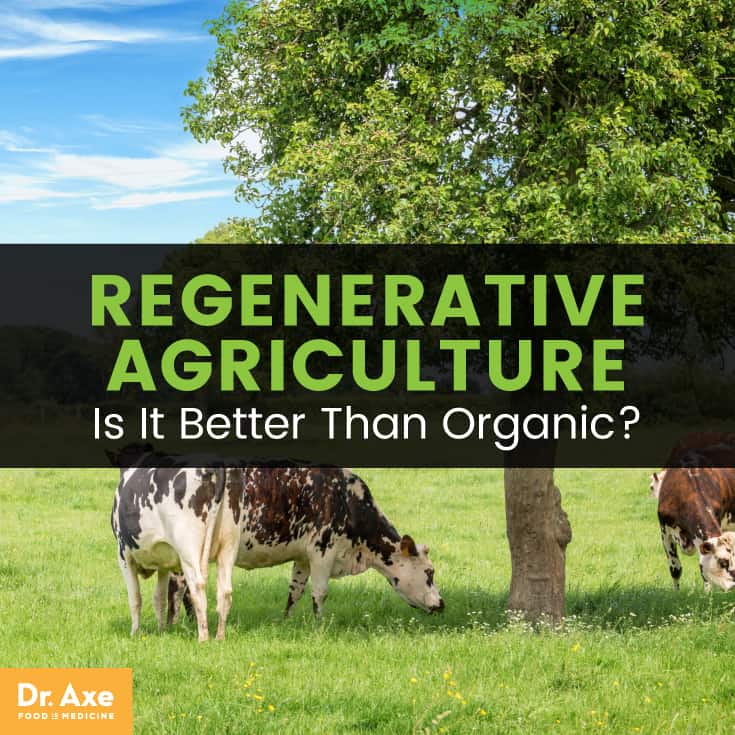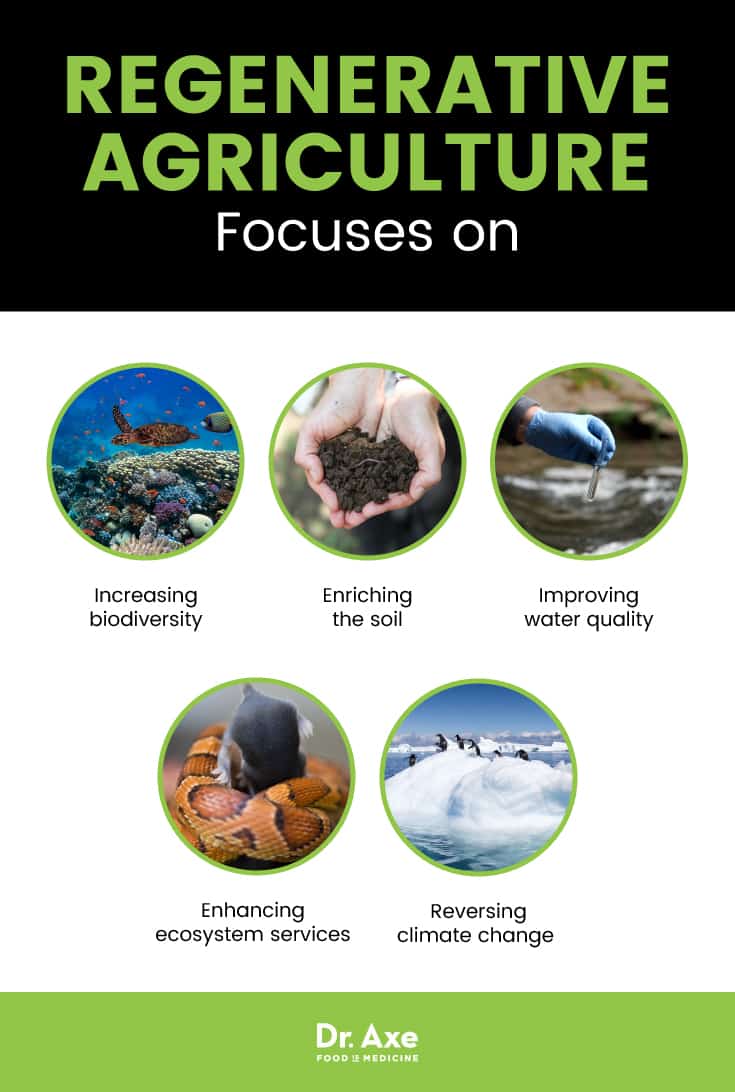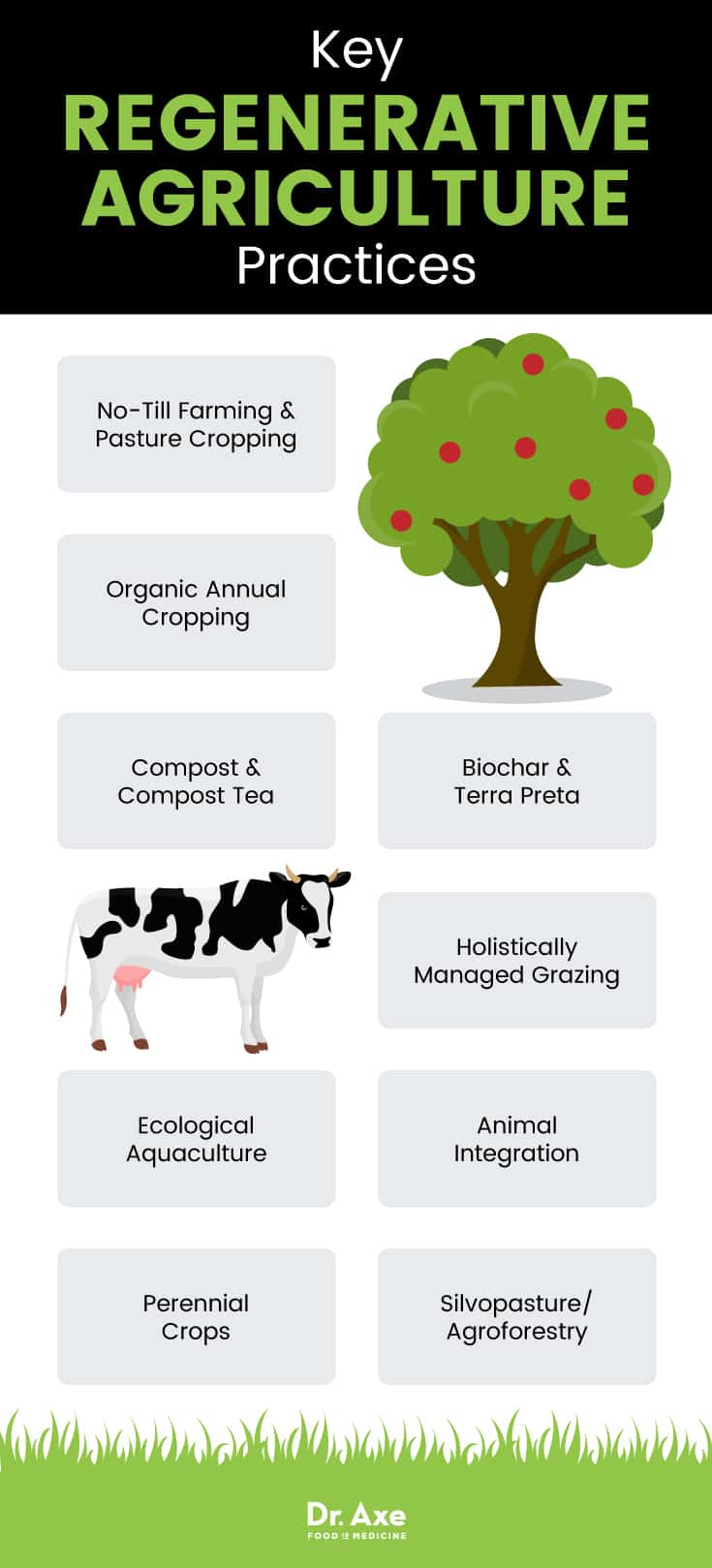Leah ZerbeDecember 5, 2017December 6, 2017

Organic. Natural. Permaculture. Regenerative agriculture. It’s a great time to get more connected to the farming practices behind our food. But what, exactly, do all of those farming terms really mean? And how do we know if they’re legit or just marketing fluff?
One thing is for sure. If we’re going to create enough food without destroying our natural resources and health, we’ve got to embrace regenerative agriculture on a major scale. But what is it, exactly? I’m glad you asked.
What Is Regenerative Agriculture?
It may be beneficial to first explain what regenerative agriculture isn’t. Have you ever driven down a country road, stumbling upon miles and miles of corn, canola or soy fields? That isn’t regenerative agriculture. That’s a monoculture system where farmers plant a lot one one type of crop. It’s not good for the soil, it’s not good for nature and biodiversity, water supplies and, oftentimes, the crops aren’t even good for people.
I really like this definition from The Carbon Underground and Regenerative Agriculture Initiative at California State University, Chico:
‘Regenerative Agriculture’ describes farming and grazing practices that, among other benefits, reverse climate change by rebuilding soil organic matter and restoring degraded soil biodiversity – resulting in both carbon drawdown and improving the water cycle.
Regenerative agriculture treats the land more holistically, taking a big picture approach instead of worrying only about crop yields. One way of putting it? It works more closely with natural tendencies rather than against them.
Instead of using abusive inputs like pesticides, chemical fertilizers, fumigants and GMOs to push the limits of production, regenerative agriculture uses a set of farming principles to not just create food, but a better world, too. In essence, it improves resources rather than depleting them.
But don’t dismiss this utopian way of farming as an out-of-reach dream. It’s already happening all over the word, and it’s scientifically-backed to boot, pulling from decades of research investigating organic farming methods, holistic grazing, agroforestry and agroecology. But more on that later.
Regenerative agriculture involves practices that:
- Increase biodiversity
- Enrich the soil
- Improve water quality
- Enhance ecosystem services
- Reverse climate change (this is especially important since we know climate change and nutrition are intricately linked)

The best side effect? It also creates higher yields and helps crops become more resilient in times of climate instability. In terms of community, regenerative farming boosts health and vitality for people living in the community. In other words, it’s better for the land and for us.
Terra Genesis International breaks regenerative agriculture into four main principles, which are further broken down into key principles. (1)
- Progressively improve whole agroecosystems
- Create context: Specific designs and holistic decisions that express the essence of each farm
- Ensure and develop just and reciprocal relationships amongst all stakeholders
- Continually grow and evolve individuals, farms and communities to actualize their innate potentials
Key practices of regenerative farming include:
- No-till farming and pasture cropping
- Organic annual cropping
- Compost and compost tea
- Biochar and terra preta
- Holistically managed grazing
- Animal integration
- Ecological aquaculture
- Perennial crops
- Silvopasture/Agroforestry (2)

Let’s take a deeper dive into some these practices below…
Agroforestry, Including Silvopasture
Practiced around the world for centuries, the United States Department of Agriculture defines agroforestry as the “intentional integration of trees and shrubs into crop and animal farming systems to create environmental, economic and social benefits.” (3)
Agroforestry is gaining momentum in the U.S. today because it gives farmers more food crop options to diversify their farm sales. A 2017 study published in Agroforestry Systems shows how incorporating berry- and nut-bearing trees and shrubs with hay and more traditional row crops can increase diversity and income for a farm.
But patience is key here. For crops like chestnuts and hazelnuts, meaningful harvests could take 7 to 12 years to materialize after planting. The idea, though, is the annual hay or vegetable crops bring annual income until the trees and shrubs produce adequate yields. The main takeaway is farmers can incorporate agroforestry to move toward polyculture instead of relying on just one crop (monoculture). (4)
USDA points out that agroforestry generally involves the four “I”s:
- Intentional (that blueberry shrub didn’t just plant itself!)
- Intensive
- Integrated
- Interactive
Here in America, agroforestry is typically broken up into five categories:
1. Silvopasture
- The practice of combining trees with livestock at the same place. The idea is that animals benefit from tree cover during heatwaves, rainstorms and other inclement weather, all while the trees provide timber, fruit or nut crops and forage.
- The combining of trees and livestock is done in a beneficial way that also promotes stronger soil health.
- Silvopasture is the most common agroforestry practice in the U.S. It’s particularly popular in the Southeast. (5)
2. Alley Cropping
- The practice of planting crops between rows of trees to generate farm income as the trees mature.
- Grains, herbs, flowers, fruit and vegetables are all examples of crops that can be planted in between tree rows.
3. Forest Farming
- Multi-story cropping where different layers produce food. This is related to food forests and food gardens common in permaculture design. Here’s a great food forest guide from Desert Echo. It includes ideas for the following food forest layers: canopy, low-tree, shrub, herbacious, ground cover, rhizosphere, vertical.
- May also provide shelter for animals.
4. Windbreaks
- Common on farms to help protect barns, farmhouses and other buildings and animals from wind, snow, dust and odors
- Known as living fences or shelterbelts
- Also support wildlife
- Choose native tree species for big biodiversity bang for your buck
5. Riparian Forest Buffers
- Riparian forest buffers are natural or re-stablished areas along rivers and streams made up of trees, shrubs, and grasses.
- These buffers can help filter farm runoff while the roots stabilize the banks of streams, rivers, lakes and ponds to prevent erosion.
- These areas can also support wildlife and provide another source of income.
Sustainable Livestock Management
This includes techniques like rotational grazing, but even more so holistically managed grazing. So what’s the difference? The Jefferson Center for Holistic Management provides nice background.
Rotational Grazing
- Focuses on moving livestock from one area of pasture to another
- Protects the soil and pasture plants from compaction and overgrazing
- Only focuses on moving the livestock to fresh pasture; doesn’t involve the timing of the moves
Mob Grazing
- Focuses on keeping a larger number of animals on a smaller tract of pasture
- But they are moved frequently, sometimes as often as three times a day
- Related to rotational grazing
- Plant recovery time isn’t part of the consideration for when to move the livestock
Holistic Planned Grazing
- Gold-standard practice
- Takes more factors into consideration compared to mob or rotational grazing
- Amount of time livestock spend on plants and recovery time needed for plants considered
- Is customized based on the social, economic and environmental factors and needs of each particular ranch
- Promotes biodiversity, so grazing plans account for nesting and breeding seasons of different animals and birds (6)
Better pasture management isn’t just better for plants and animals, either. It’s also great news for more breathable air and a healthy atmosphere. Cows raised on pasture using best management practices produce roughly 22 percent fewer methane emissions. Methane is a potent greenhouse gas. (7)
Sometimes, though it’s images, not words, that can really convey a message. Check out this video showing conventional land versus holistically managed land.
As you can see, careful planning can drastically improve biodiversity and health both above and below the soil
Carbon Helps Climate Change
Healthy soil is teeming with microorganisms that help store carbon in the soil, keeping it out of the atmosphere where it promotes climate change. I’d like to think there are parallels we can draw from the microbiome and gut health. When our digestive tract is flourishing with diverse, beneficial microorganisms, we are healthier. The same is true of our soil. The truth is, shifting to regenerative agriculture on a major scale could return atmospheric carbon dioxide levels to pre-industrial levels, in effect reversing global warming. (8)
Research from the Rodale Institute, an organic experimental farm in Pennsylvania, shows that regenerative farming is a legitimate tool for not just slowing, but actually reversing, climate change.
Here are some major points in the Rodale Institute’s 2014 white paper:
- If we took all currently available cropland and shifted it to regenerative organic agriculture methods, up to 40 percent of annual emissions could be captured in the soil.
- Adding pastures around the world to the regenerative agriculture model could increase the amount of carbon stored to 71 percent.
- The good news? Nothing needs to be invented to create this type of carbon sequestration. It’s available now, costs little to implement and as a side benefits, reduces the need for cancer-causing farming chemicals. (9)
Many regenerative agriculture techniques help promote healthier carbon levels in the soil, including:
- Crop rotation
- Compost
- Residual mulching
- Cover crops
- Conservation tillage (10)
Crop Rotation
Growing the same crop year after year in the same spot is a recipe for pest infestations, diseased plants, the need for toxic chemicals and lower yields. But when you smartly plan and plant your crop rotation, you can build up the soil and grow truly resilient plants.
While the most widely known benefits of corp rotation include nutrient retention and nitrogen fixation, which serves as a natural fertilizer for the next crop. But there are other benefits to consider, too. Certain crops influence the rhizosphere around the root systems, causing some minerals to be more easily utilized by the next crop. This will help boost the next crop’s plant health and immunity, which often results in higher yields, according to Advancing Eco Agriculture. The idea is that something planted today will change the soil in a way that influences future crops. (11)
Compost
Compost is the result of recycling organic matter and using it as a soil amendment. It’s also a hallmark of regenerative agriculture. Rich in humus and humic acids, compost also serves as a natural pesticide in the soil. Basic DIY compost principles involve taking waste like leaves and food scraps and allowing worms, fungi and aerobic bacteria to convert it to a soil enhancer. (12)
Compost helps saturate the soil with missing microbes, reducing the risk plants will suffer from nutrient deficiencies, diseases, insect damage and drought-related stress.
There money to be made when it comes to compost, too. Some farms that nix the use of chemical fertilizer and transition to using compost and compost tea experience savings in the hundreds of thousands of dollars range! Better soil, healthier crops and lower bills. Who could argue with that? (13)
And did you know compost benefits also include a reduction in soil erosion? This has two major benefits. First, it helps the soil store more water, which field tests show help increase organic crop yields during years of drought. (Organic crops actually outperformed industrial, chemical agriculture crops in years of drought because of this.) (14)
Soil scientist Elaine Ingham, PhD, is an advocate of thermal composting, something you can even try at home.
Perennial Crops
A common practice in regenerative agriculture involves planting perennial crops. While not all crops on a regenerative farm need to be perennial, shifting more land into perennial crops and pastures helps minimize soil disruption. This is a key concept of permaculture, where design focuses on replicating how things work in nature. It’s like working with nature to create food, not against it. And the idea is that with this permanent design, the workload becomes easier and the crop yields increase with time. Multi-canopy food forests are also key permaculture concepts utilized by many regenerative farms. (15)
In fact, permaculture and regenerative agriculture can work hand-in-hand as an effective way to feed the world without using chemicals. (16)
Regenerative Agriculture vs. Permaculture vs. Organic Gardening
While there is some overlap between regenerative agriculture, permaculture and organic farming and gardening, there are notable differences, too.
Organic Farming/Gardening
“Organic agriculture provides a base set of standards. It’s all about minimizing toxins and slightly maximizing nutritional value, although the studies are mixed,” Jordan Rubin, founder of Heal the Planet Farm explained. “The main gist is producing food not laden with chemicals.”
That’s certainly good news and a vast improvement from industrial farming. After all, scaling up chemically produce food means we now have a “dirty dozen” list of foods to avoid. I’m so thankful organic is getting carcinogens, neurotoxic substances and bee-killing chemicals out of the food change.
But it can go much further to become a truly sustainable system that can feed the world. One problem? Many organic farms produce annual crops and raise meat and dairy animals on outside food sources. “That’s not necessarily regenerative,” Rubin explained to. “It could be creating a system that needs loads of inputs.”
While organic farms are much healthier for people and the environment because they don’t rely on harmful chemicals, many larger organic producers may not encourage biodiversity as much as regenerative farming models.
Organic farms often also plant annual row crops that are more disruptive to the soil; trucking in off-farm inputs, even though they are more natural and approved for use in the organic program, are common. Organic farming is often not a closed-loop system.
Permaculture
Permaculture is simple. The goal involves creating permanent systems of agriculture through perennial crops and animals. As Rubin explains, the roots grow deeper each year, leaves and nuts’ shells improve soil, resulting in more food, better soil and working less. Edible food forests are hallmark of permaculture, in addition to utilizing all of earth’s resources (water, sun, wind) and relying as little as possible as modern equipment and off-farm inputs.
Permaculture focuses on planting perennial crops in a way that replicates and works with nature. Permaculture does not focus on planting annual crops like tomatoes, corn and other popular farm crops that need to be seeded each year. Permaculture also focuses on not using inputs that come in from off the farm. The idea is that it’s a closed system that, with time, grows stronger and produces more food without trucking in compost and soil amendment mined or created in other places.
Regenerative Agriculture
The basic idea? Improving the soil with every harvest, instead of robbing it. Each year, regenerative farming will improve plant, soil and animal health.
Regenerative agriculture does take permaculture into account, but annual crops are also part of many regenerative agriculture farms. Both permaculture and regenerative farming use organic methods but go beyond organic to create even more sustainable food systems. (17)
Some of the better organic farms and gardens around the U.S. adopt permaculture and regenerative agriculture principles, although they are not currently required. In the U.S., organic farms are banned from using chemical pesticides, fertilizers and GMOs. (18)
But to help make organic even stronger, the Rodale Institute and a team of other farmers, ranchers, nonprofits, scientists and sustainable brands are creating a Regenerative Organic Certification program.
This program focuses on guidelines that will improve:
- Soil health
- Land management
- Animal welfare
- Farmer and worker fairness
Regenerative Agriculture History + Its Pioneers
Pushing the land beyond its limits to create food isn’t just something happening now. Take the Dust Bowl, for instance. Thankfully, regenerative pioneers of the past and present are pushing forward to farm in a way that improves resources rather than destroying them. This is the farming of the future, not GMOs and chemicals.
Here are some of regenerative agriculture’s leading pioneers:
Sir Albert Howard
A botanist known as the leader of the early organic movement and father of modern-day agriculture, Sir Albert Howard made a vital discovery when he traveled to India during his career: The healthier the farm soil, the healthier the people living in the community. He took his learnings from India and shared them through the UK Soil Association, urging people to model farming after forests. This includes maintaining humus and moisture in the soil, along with the importance of mycorrhiza, beneficial fungus that bolsters plant root health. (19)
J.I. & Robert Rodale
As founder of the Rodale Press book and magazine publishing empire in 1930, J.I. Rodale clearly saw a connection between agriculture and human health. He popularized the term “organic” in the U.S. in the 1940s and drew inspiration from the regenerative farming ideas of Sir Albert Howard.
In the 1940s, he created the Rodale Organic Gardening Experimental Farm. Today, it’s known as the Rodale Institute, and it’s still doing great work involving soil health, climate change and farming and composting. (20)
His son, Robert, later coined the term “regenerative organic agriculture” in the 1980s. He was referring to the idea of farming marked by:
- Closed nutrient loops (think less chemical fertilizer and more compost)
- Greater diversity in the biological community
- Fewer annual crops and more perennial crops
- Greater reliance on internal versus external sources (21)
Elaine Ingham, PhD
A world-renowned soil scientist and author, Ingham is founder of Soil Foodweb Inc., where she offers classes on how to build soil health using natural methods. Previously, she also served as chief scientist at the Rodale Institute. Ingham authored chapters in The Soil Biology Primer for the United States Department of Agriculture’s Natural Resources Conservation Service, and she currently is the director of research at the Environment Celebration Institute’s farm in California. Ingham’s decades of scientific research has resulted in hard data that shows the benefits of building up the soil with compost and compost tea. (22)
Jordan Rubin
A bestselling author, co-founder of Ancient Nutrition and natural health expert, Rubin is also founder of Heal the Planet Farm, a regenerative permaculture retreat located in Missouri’s Ozark mountains. It lies within the 4,000-acre Beyond Organic Ranch.
Heal the Planet Farm’s 7-year plan involves creating organic polyculture orchards with as many as 100 different fruit and nut trees, perennial vegetables and medicinal herbs. All the while, the focus will be on building soil fertility to sequester carbon from the atmosphere.
The goal? To take some of the worst soil on the planet in the Ozark region and create soil with 10 percent organic matter. By building topsoil levels up to 30 inches using innovative permaculture and regenerative agriculture principles, the land could have the ability to hold 10 inches of water, which is key to soil fertility.
“Our message is this: If we can build healthy soil here, we can teach anyone to do it anywhere,” Rubin said.
With regenerative and permaculture workshops already being held on the farm, the hope is to train farmers to provide nutrient-dense food for the entire planet by the year 2100 on just the farmland in America.
Using mixed species rotational impact grazing, including mixed species like water buffalo, yaks, cattle, goats, sheep, chicken and donkeys, the farm will build diverse balance in the soil as the species mimic how animals move in the wild.
Joel Salatin
A co-owner of Polyface Farm in Virginia, Salatin is also known for taking on the GMO industry, pointing out that we don’t need to grow more food to feed the world … we need to get the food we typically waste (up to 50 percent grown or raised) to people who need it. (It’s often political unrest and war block people from food). He was highlighted in Michael Pollan’s Omnivore’s Dilemma, and you may also remember him from Food Inc.
Salatin’s farm produces grass-raised, clean meat. In fact, he told Resilience that without planting a seed or buying a bag of chemical fertilizer in over 50 years,” Polyface is producing five times the county average compared to other farms. He focuses on moving his animals from pasture plot to plot in a way that better mimics how animals move in nature. (23)
Final Thoughts on Regenerative Agriculture
- Regenerative agriculture uses many organic farming principles but takes things further in the positive direction by going beyond organic.
- Regenerative farming can be broken into four main principles: Progressively improving whole agroecosystems; creating context and using specific designs and holistic decision making specific to each individal farm; ensuring and developing just and reciprocal relationships amongst all stakeholders; and continually growing and evolving to actualize and evolve individuals, farm and communities.
- Key practices on regenerative farms include: no-till farming and pasture cropping; organic annual cropping; compost and compost tea; biochar; holistically managed grazing; animal integration; ecological aquaculture; perennial crops; and silvopasture, a common form of agroforestry.
- Many organic farming principles are used in regenerative farming, but regenerative methods go even further.
- Regenerative agriculture reduces the need for off-farm inputs and aims to leave the soil healthier
- While so many people have played a role in growing the regenerative agriculture movement, some pioneers include J.I. and Robert (Bob) Rodale, Sir Albert Howard, Elaine Ingham, PhD, Jordan Rubin and Joel Salatin, among others.
https://draxe.com/regenerative-agriculture/
On – 05 Dec, 2017 By Leah Zerbe




